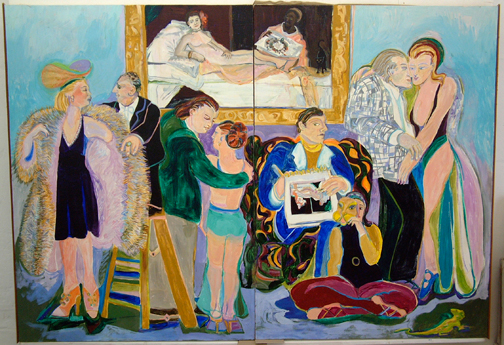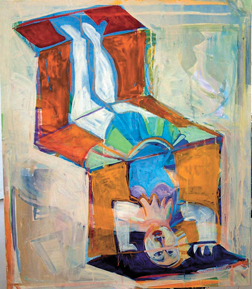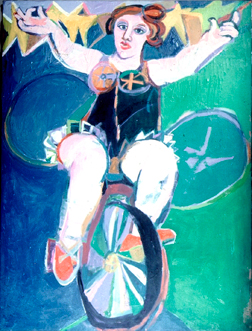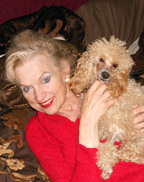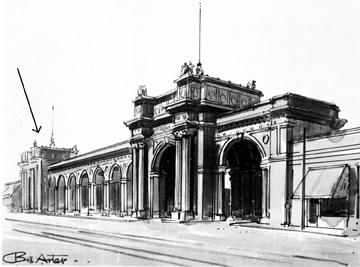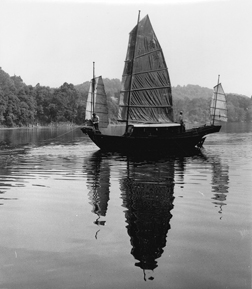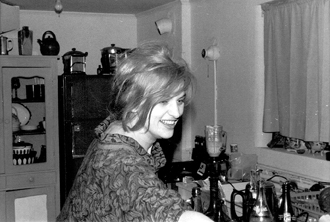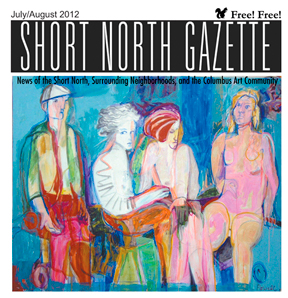
Columbus, Ohio USA
Return to Homepage www.shortnorth.com
An Artist, a Chinese Junk, and Old Union Station
By Cynthia Rosi
July/August 2012 Issue
Return to Homepage
Return to Features Index
Olympia, 2011 One afternoon a young artist walked by a “For Rent” sign. It would become a defining moment both for her and for the arts community in Columbus.
The artist was Diane Powell, and the rental was part of Columbus’ Union train station. For just over a decade beginning in the late ‘60s, Powell’s residence there would become a hub for artists, academics, and collectors to gather and exchange ideas.
“They couldn’t rent it to anybody,” recalled Powell, who will be showing at Sharon Weiss Gallery, 20 East Lincoln Street beginning on August 3 for one month. “It was gorgeous – it had a balcony and three stories in the middle, Beaux Arts architecture, and in the basement was the body of an old railroad locomotive.”
When Powell first took possession of the High Street frontage, it was quite dilapidated, in need of paint and wall repair, so she got it for a low monthly rate of $50. “It was absolutely abandoned,” said Powell. “We hired some people from West Virginia to paint it. They put masking tape over all the holes in the wall and painted the whole thing cream. It was just lovely. It was perfect because the paintings showed up really well and the ceilings were high enough and it had that wonderful balcony. There was a place to park in the back. And it was totally deserted. It was wonderful.” Later, she acquired the adjacent space for an additional $50 and they allowed her to blast a hole between the buildings to add a door.
Powell’s friend of 45 years, Lee Burges of Grandview, remembers the station as a cavernous place to live and fertile ground for artists to meet and talk. “There were maybe ten to twelve frontages on High Street that had held different offices when the train station was operating in its day. Huge, huge rooms. Her main living room had a balcony which she used as a bedroom, and a self-made kitchen of sorts, and a shower stall; then she had five to six rooms at that time: printmaking in one room and painting in the other room. She would have big dinner parties and rent round tables. I can remember a dinner party for 65 people one weekend.”
Zigzag Woman, 2012 For Powell, living in the once-grand abandoned station not only brought her the opportunity to experiment, to paint on large canvases and work on big public projects, it also brought her an important realization. “The one thing it did for me – and this is for real – I realized nothing is cast in stone. Everything changes.”
As she expanded into the space, friends and visitors came knocking: “The whole Ohio Arts Council, my friends, people from around the state would stop by – we had a changing landscape of arts people. It was a very exciting, dynamic time.”
MISSING ART
The Unicylist, by Diane Powell went missing in 2005 after the passing of Capital University Professor Richard Phipps and the subsequent removal of items from his office, including Powell’s painting which had been loaned to him. Oil on linen, approximately 34” x 52, The Unicylist was last seen with a strip frame in Phipps’ office. A reward is offered for its return. Call Diane Powell Dax at 607-538-1799 or email ddax@dmcom.netWayne Lawson, retired executive director of the Ohio Arts Council, was a controversial young chairman of comparative literature at The Ohio State University while Powell was living in the train station complex. She struck up a conversation with him during her studies at OSU, and they became firm friends.
“That historic building said a lot about what Columbus was, and little did we know where it would go,” Lawson reflected.
“Actually built on that place is the convention center – look what’s happening now: growth, growth, growth. Columbus is really coming into its own.”
Powell not only attracted eclectic people, she also had eclectic things. During graduate school, she and her brother Bruce, and her then business partner, now husband, David Dax, ran an import shop called Trade Winds (later acquired by Libby Gregory and her two partners). Amazing stories about the operation of the business range from a shoplifter who stole a Civil War sword down his pants to the Black Panther high as a kite coming in, and Allen Ginsberg, the beatnik writer, shopping there.
“We had everything before anybody else did,” said Powell, “like rugs from Thailand, dresses from Persia, antiques, handmade earrings, nougat from Spain, Scottish tartans from Edinburgh, beads, coins, custom sandals, and select unique items like John D. Rockefeller’s bicycle.”
The trio would routinely scour auctions for collectibles, and when they came across an authentic Chinese junk, they knew exactly what to do with it: put it in the basement of Union Station.
“My husband saw it up on Lake Erie,” Powell recalled. “It was owned by a puppeteer, but they had a baby. Babies and Chinese junks don’t mix,” she said with a chuckle. “We got the junk – it was really fun. It has big sails with battens through them. Those are sails one man can raise one section at a time. It’s 35 feet long and sleeps six people and it’s very rough. It’s all made by hand. It’s more like sculpture. We put it in the river in Zanesville and sailed it down [the Ohio River] at Marietta.”
Diane Powell, 2012 For Lawson, Union Station, the Chinese junk – which he remembers half-sinking in the Muskingum – and Diane Powell, all link in his memory. “She truly was an inspiration. She’s got a deep feeling, and we were able to all come together with her at the center of it.
“Name an issue or a movement and we were discussing it or involved in it. We were a pack of liberals in a train station thinking that we could possibly resolve all the problems around us. Diane would just invite people – you never knew who was coming that day. It was communication at its best – discussion, confrontation. Each one of us took that away with us.”
Powell comes from a family of lawyers – mother, father, grandfather and great-grandfather – but knew she’d be a painter since age four. Born in Cincinnati, she eventually left Ohio for the Chicago Art Institute and transferred back to OSU where she also earned her master’s degree. She learned literally how to see color from Hoyt Sherman who gave her eye exercises to use the whole surface of the eye.
“Once you do that, you see the picture plane differently,” Powell explained. “You become familiar with it and then you train your eyes to see more, and you do that with eye exercises. The government did that with fliers …trained them to use peripheral vision.
“You learn about color acting in two ways: hue, which is color quality, and as a value which is black and white. If you squint your eyes almost shut, [an object] turns into white-and-black patterns. That’s called the value structure. [Seeing like this] becomes a way of thinking.”
This sketch by Bill Arter looks north along High Street.
Diane Powell’s residence is on the far left (under the arrow).During graduate school, the young painter won an artist-in-residence at the Munch Museum in Norway where she lived in the museum and battled with its rudimentary security system – a Rottweiler named Ivan. “The only excitement he had was when I went past him,” Powell laughed. “They had a glass cage to see what packages people had when they went in and out of the museum, and he was kept in there at night. I would try to go out, and he would leap against the glass wall. I would get down on all fours to crawl out of the museum and get back in the same way. I always thought he would break through and kill me.”
At OSU, Powell began graduate work in sculpture because it offered 95 hours of independent projects compared to painting’s 60 hours. She took the extra hours to paint, but also learned a sculptor’s craft. In addition to going to Norway, she learned printmaking in Japan during her degree program.
At Union Station, she experimented with big paintings but also had the room to sculpt. “Sculpture’s important because it occupies three dimensions,” Powell said. “I love clay because it’s malleable. Bronze takes what’s malleable and makes it permanent. Some materials are very hard to work with, like steel and car parts.”
In the early ‘80s, the Ohio Historical Society commissioned Powell to make 65 graphic portraits on copper of famous Ohioans, including Clark Gable. “They had one guy [a portrait subject] – they said he was a famous librarian – I didn’t know that was a category. The picture they had of him was two little smudge shapes for cheeks, so I got to create my own famous librarian!”
As a second part of the contract, she completed nearly a dozen four-feet-across woodcuts of typical Ohio scenes such as harvest and school time.
Powell remained true to her painting during her time at Union Station; the Student Union at Dennison bought the painting titled Stay High – a man flying through the air with a suit on and an impeccable tie.
The Chinese junk purchased by David and Diane while living in the train station is 35 feet long and sleeps six people. “It’s all made by hand. It’s more like sculpture,” says Diane. “Diane was prolific in terms of her work, and passionate, and bright – colors bright, Diane bright, the people around her bright,” said Lawson. “She was a colorful personality, and she remains a colorful personality. What a circus it was. She was always painting… and curiosity. That’s another key word for Diane, curiosity.”
“I paint consistently the people in my head,” Powell said. “I’m only interested in doing that. It works if it’s funny. I like changing scale – I like big and little, three big men and one little lady in the middle.
“I don’t do very well with people telling me what they want. One time I had a couple that wanted a painting of a cow, but I painted these daffodils – five feet high, gorgeous color. That’s what she wanted, she didn’t really want the cow. When we got the cow in there, we were done for! I painted her out.”
Even so, Powell has painted on commission for the Supreme Court of Ohio. “They wanted me to do a painting of Florence Allen – first woman jurist. I was experimenting with different shapes and wasn’t into making the shapes look like her. It’s all right, it honors her, and that’s what it’s meant to do.”
Powell’s time in Columbus drew to a close, her destiny linked to Union Station. The city council earmarked Union Station for demolition, paving the way for the Convention Center and Arena. “We knew the handwriting was on the wall,” Diane said. “In the meantime, I’d found a fantastic studio in Dutchess County, New York – it was different, more like a hidden garden, whereas at the train station people would stop by and hang around the door. It was a different world.”
Shortly after moving out of Union Station to a temporary studio elsewhere, she created a bronze-over-epoxy globe with astrological signs, and gold, silver and nickel stars for the Caspian Building on Riverside Drive.
It's party time at Union Station with Diane. But nothing in Columbus filled the void created by Powell’s departure and the demolition of the artistic and intellectual community that had sprung up around Union Station. “When they went to New York, she was missed a great deal,” said Burges. “Everybody functioned, but missed her a great deal. I think everybody assumed she’d be back. They went on with their life there and moved to upstate New York where they raised their daughter.”
When the Granville Opera House burned down, the town commissioned Powell to create the Once Upon a Time sculpture, now a local landmark. “I put a ship coming into port [on the sculpture book] because of the famous poem: ‘there’s no frigate like a book to carry you miles away.’ The ship is the Bonhomme Richard because the guy who was chairman of the committee was Richard.
“They made a base constructed from stones from the old opera house and put the sculpture on it. I made the sculpture in New York, and we brought it back and there was a lot of celebration, and I like that.” Powell’s current studio is in South Kortright, New York.
The Union Station gave Diane creative stimulation, and plenty of room to develop. “The time in Columbus was spent experimenting and finding what my true direction was, and after coming to New York I explored doing things in series. The more experiences you have the more you can draw upon. It’s important to see how people can get emotional and get meaning from something you might have passed by.”
For Burges and Lawson, the paintings collected while Powell lived at Union Station have become personal treasures. Powell’s curiosity and love of color, her juxtaposition of themes which creates a look-twice feeling in the viewer, make her work enduring and enjoyable.
“A painting is a painting, and it has its own truth to it,” said Powell. If it communicates it goes beyond lines on paper and formal content, just like music does. It’s complex. You don’t have to realize the complexity to enjoy the music – the same with painting.”
“Diversion,” an exhibit of Diane Powell Dax’s recent paintings will remain on view during the month of August at Sharon Weiss Gallery, 20 E. Lincoln St. An opening reception with the artist will be held Friday, August 3 from 6 to 8 p.m. Call 614-291-5683 or visit www.sharonweissgallery.com
© 2012 Short North Gazette, Columbus, Ohio. All rights reserved.
Return to Homepage www.shortnorth.com
